When done correctly, option trading is one of the most effective ways to build wealth over the long haul.
If you’re new to the stock market or investing, the terms option strategies and option trading strategies might be foreign to you.
But don’t worry—we’ve got you covered as this article shall examine the top 10 most profitable option strategy every investor and strategist should know.
A contract known as an option gives an investor the ability to buy or sell an underlying instrument, such as a stock or even an index, at a predetermined price and for a predetermined amount of time in exchange for a premium paid by the buyer to the seller.
In this blog post, we’ll talk about some of the top profitable option trading strategies that we believe any trader or investor should at the very least be familiar with.
Table of Contents
Key Takeaways
- Options trading may appear complicated, but most investors may apply several fundamental techniques to increase returns, predict market movement, or hedge their current positions.
- If you currently hold a stake in the underlying shares, covered calls, collars, and married puts are used.
- In a spread, one (or more) options are purchased while another (or additional) options are simultaneously sold.
- When the market moves either up or down, long straddles and strangles are profitable.
See also- TikTok Monetization: How Much Does TikTok Pay Per View
10 Most Profitable Options Strategy Every Investor Should Know
These top option trading strategy are listed below for your consideration.
Your trading style will determine whether you choose to apply these tactics, but at the very least, if you are aware of how they operate, you will be better prepared to adjust to shifting market conditions.
The top 10 most profitable option strategies every investor should know are;
- Long call & put options
- Short call & put options
- Covered call
- Married put (at-the-money)
- Straddle
- Strangle
- Iron condor
- Broken wing butterfly
- Protective collar
- Diagonal spread
1. Long Call & Put Options

Those who purchase long options can bet on the notional value of 100 shares of stock without having to invest nearly as much money as those who buy 100 shares of stock outright.
Long-put purchasers bet on the stock price falling quickly, while long-call buyers bet on the stock price rising quickly.
Let’s explore each choice type in more detail below.
The most fundamental options strategy is regarded as a long call.
It is a contract that allows the owner the option to purchase the underlying asset at a fixed price (known as the strike price) by a specific expiration date, such as 100 shares of stock.
One of the three key features of an options contract is the expiration date, along with the strike price.
The third one is the premium, which is the sum that the buyer must pay the seller in exchange for the privilege of holding, for a brief time, what would theoretically be 100 shares of stock.
The counterparty, or the seller, is required to deliver 100 shares of stock to the call owner if the stock price is higher than the strike price at the contract’s expiration even if the buyer is under no duty to exercise the right to purchase the shares. (This is what is meant by “assignment”).
Profits are earned when the underlying market price exceeds the sum of the strike price and the premium paid at expiration.
Buyers of long calls often have a positive market assumption.
Since long call options lose ALL of their value if they are still out-of-the-money (OTM) at expiration, many traders use long call contracts as a speculative tool and trade in and out well before expiration.
If the trader exits the position before expiration, call contracts can rise in value in response to a bullish movement in the stock price even if the stock price never reaches the call strike price.
Moreover, the closer you are to the stock price, the more the premium for a call option will be;
Conversely, the lower you are, the less the option will be worth.
The less valuable the choice will be, the further OTM you are.
Learn more about Long Call & put options
2. Short Call & Put Options
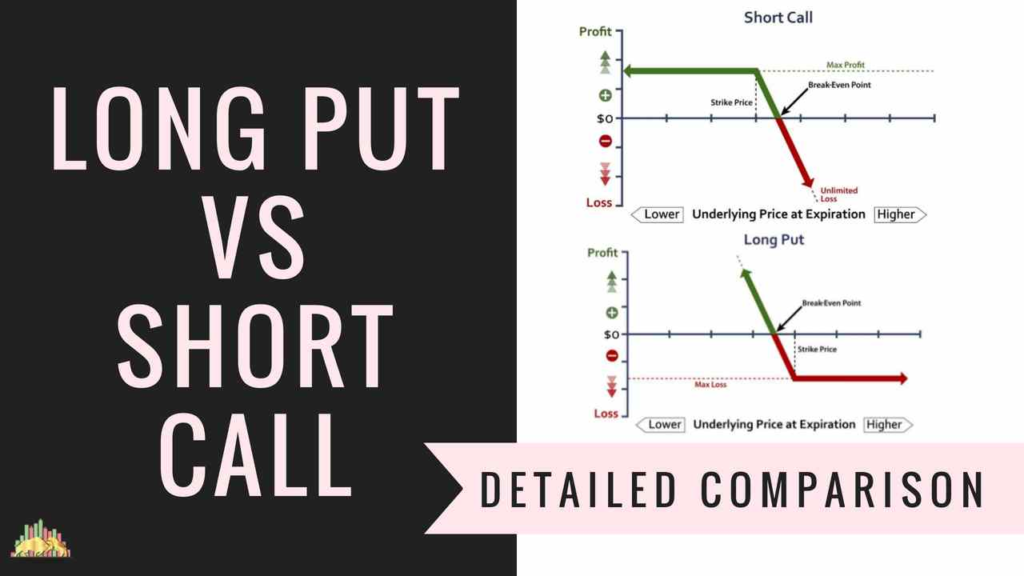
This comes second in the list of the most profitable option strategy every investor must know. In contrast to their long-option counterparts, short-options are the exact opposite.
Short option sellers bet against the movement of the stock price to or beyond the strike price rather than on the movement of the stock price towards or past the strike price.
Option sellers take the risk of 100 shares of long or short stock above the strike price, thus their profit potential is limited to the credit they receive up front for selling the option.
However, they also have an undefined loss potential.
Since they both profit from the stock advancing away from the strike price, put and call sellers are considerably more directional neutral trades than buyers since, if the strike expires OTM, they can also tolerate some movement in the opposite direction.
In the sections below, we’ll go further into short calls and short puts.
Since there is no upper limit on the possible rise in stock price, a short call is a neutral to the negative transaction with limitless risk and a specified reward potential equal to the credit obtained upfront.
By betting against the stock price increases above the short call by the time their contract expires, short option sellers are betting against the movement of the stock price; nevertheless, even if the stock price remains flat or slightly rises, they can still make money.
The call seller retains the premium received upfront as profit as long as the contract remains out of the money.
If a call seller experiences losses at expiration, it’s because the stock price is higher than the call strike by more than the upfront credit.
With less intrinsic value left in the option as it approaches expiration, short-call holders are more likely to be required to deliver 100 shares of stock if their option is exercised.
A short put is a neutral to bullish investment that has a restricted risk of the stock falling to zero and a specified profit potential equal to the credit earned upfront.
Short put sellers profit if the stock price remains higher than the put strike until expiration, but these options lose value if the stock price rises quickly, just as calls lose value if the stock price declines rapidly.
If the stock price falls below the put strike price at expiration, short put sellers are required to purchase 100 shares of stock at their strike price.
Short puts are a common strategy among investors who want to buy 100 shares of the underlying they’re trading at a lower price than the market is currently offering.
This enables traders to use short puts as a way to buy 100 shares of stock at a lower cost basis than buying the shares outright in the market.
3. Covered Call

Purchasing a naked call option is one method for dealing with calls.
A basic covered call or buy-write arrangement is also an option.
Because it produces income and lessens part of the risk associated with holding a position in a single company, this approach is very well-liked.
You must be prepared to sell your shares at the short strike price in exchange for this trade-off.
You buy the underlying stock as you normally would carry out the strategy while also writing—or selling—a call option on the identical shares.
Assume, for instance, that a trader is utilizing a call option on a stock that corresponds to 100 shares of the underlying stock.
The investor would sell one call option in addition to purchasing 100 shares of the stock.
Because this investor’s short call is covered by the long stock position, the strategy is known as a covered call if a stock price rises sharply.
When holding a short-term investment in the stock and being undecided about its future course, investors may decide to employ this tactic.
They might choose to sell the call premium to make money or to hedge against a possible decrease in the value of the underlying stock. This is no 3 on the list of the Most Profitable Option Strategy.
Learn more about covered call strategy
4. Married Put

A married put strategy involves the investor buying both put options and an asset at the same time, such as stock shares.
A put option contract is worth 100 shares and gives the holder the right to sell stock at the strike price.
This approach may be used by an investor to reduce the chance of losing money when keeping a stock.
If the stock price drops significantly, this technique sets a price floor, acting similarly to an insurance policy.
It also goes by the name “protective put” for this reason.
As an illustration, let’s say a stockholder simultaneously purchases 100 shares of stock and one put option.
If the stock price takes a negative turn, this investor may find this method intriguing because they are protected from the downside.
Likewise, if the stock’s value increases, the investor would be able to take advantage of all potential upside.
This strategy’s lone drawback is that the investor forfeits the sum of the premium paid for the put option if the stock’s value does not decrease.
5. Straddle
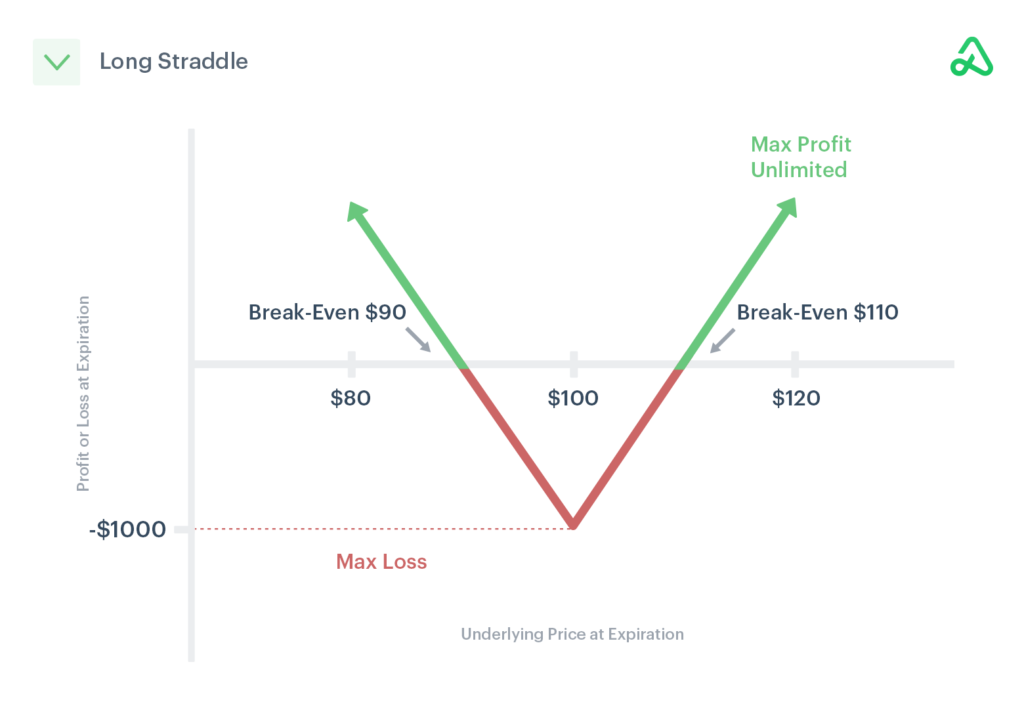
Options traders that assume no bias in direction utilize the straddle trading method.
A put and a call at the money (ATM) are also simultaneously held in this position.
Although this approach uses a variety of option types, everything else is the same: all of them are either long or short positions, and the underlying, strike price, and expiration date are all the same.
The holders of long straddles have a fixed risk and a limitless possibility for profit.
No matter which way the stock price moves, the buyer of a straddle anticipates that it will move substantially past the strikes.
The stock price must increase beyond one of the strikes by more than the debit paid to initiate the trade to make money upon expiration.
The risk is unlimited while the profit potential is constrained to the credit earned for selling the straddle in short straddles.
Short straddle sellers often utilize it in environments with higher implied volatility because they anticipate that the stock price will remain within that range.
The buyer of a long straddle is making a wager that the real movement in the stock price will be higher than the indicated movement based on the price of the straddle itself in low implied volatility (IV) circumstances.
Furthermore, the straddle can be sold for a profit if the market goes significantly in one direction.
6. Strangle
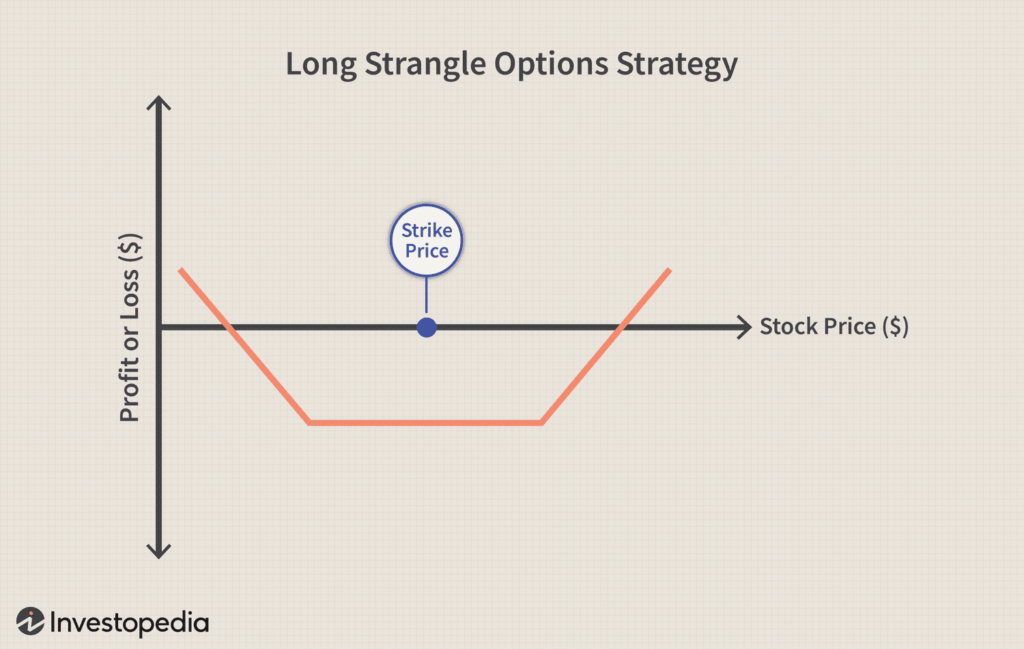
Straddles and strangle options are related in several respects.
A strangle is a neutral trading method that uses a call and a put with the same underlying, expiration date, both of which have to be either long or short.
The strike prices in straddles are slightly in-the-money (ITM), not OTM.
Traders who believe that realized volatility will be strong in the short term frequently adopt the long-strangle approach.
While potential rewards in long strangles are limitless, probable risk is defined.
Similar to straddles, long strangles are frequently employed in low IV circumstances when the trader anticipates realized volatility to surpass implied movement.
Traders that don’t anticipate significant price changes in an underlying generally use short strangles.
The net premium gained in a short strangle is the greatest profit assuming the stock price stays between the short strikes, whilst the risk is unknown.
Since traders are betting against the implied movement of the underlying, short strangles are frequently used in high IV conditions.
7. Iron Condor

Due to the iron condor’s specified risk profile, it’s one of the options strategies that enables traders to manage their capital more effectively.
A short call vertical spread and a short put vertical spread that are both out-of-the-money (OTM) make up an iron condor in essence.
A short call vertical spread, which is bearish, is created by selling one call and purchasing another at a higher strike price to specify the risk on the short call.
In contrast, a short put vertical spread, which is bullish, is created by selling one put and purchasing another at a lower strike price to specify the risk on the short put.
Both spreads have the same underlying and expiration date, but the strike prices and spread widths may vary.
An iron condor is a neutral strategy since the bullish and bearish spreads directional offset one another.
Profits are realized through the trading of the underlying inside the short strikes; the maximum profit is achieved at expiry if all options expire worthless, and it is only as much as the credit obtained at the time the iron condor was sold. This is placed as one of the most profitable option strategy.
Learn more about Iron condor trading
8. Broken wing Butterfly

A neutral or directional option strategy is a broken-wing butterfly.
The short strikes in a broken-wing butterfly are the same in both the debit and credit spreads.
The goal of “breaking the wing” is to make the credit spread wider than the debit spread and, in the end, finance the entire cost of the debit spread we acquire and route the trade for credit.
By doing this, we eliminate the risk associated with options expiring at the money since even if all of them do, we will still make a profit equal to the credit we were given in the beginning.
As the long debit spread would be at its maximum value and the credit spread would be worthless, the most profit is made if the stock price is on the short strike at expiration.
Max profit equals the sum of the credit earned up front and the debit spread’s width.
The maximum loss is equal to the width of the credit spread less the upfront credit received and the breadth of the debit spread.
When the entire spread expires in the money, the maximum loss is realized.
The broken wing butterfly options method is frequently used for credit to completely remove risk from the OTM side.
Also, this means that for broken-wing butterflies, our maximum reward and risk is to the downside, even though we have no risk when going for credit if the stock price rises.
In the case of call broken wing butterflies, this implies that even if the stock price declines, we have no risk when we route for credit, but that our maximum reward and risk lay on the upside.
Learn more about broken wing butterfly
9. Protective Collar
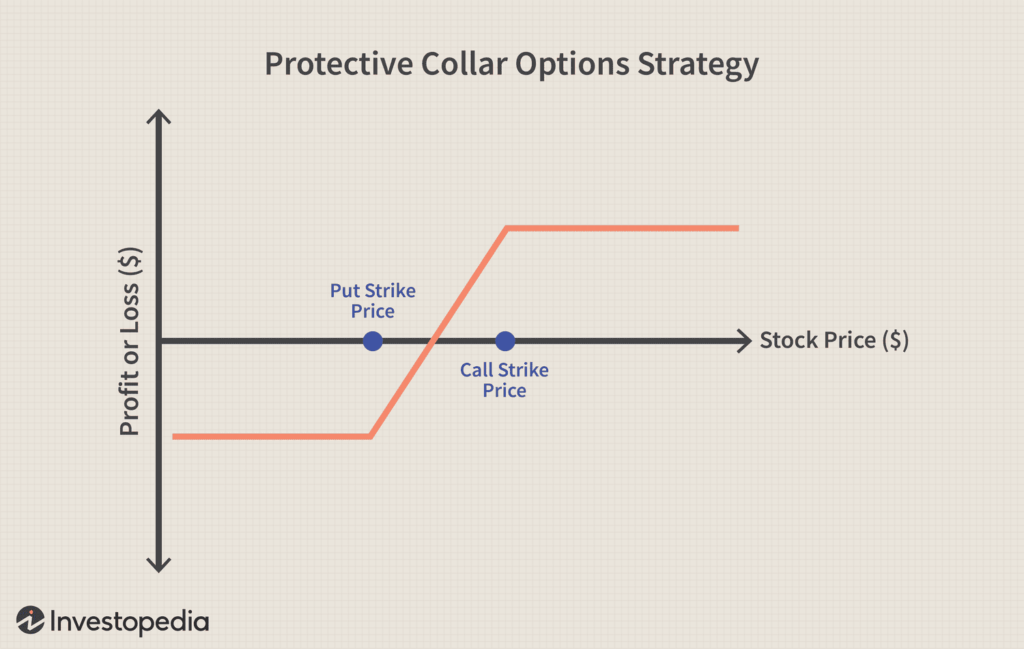
Similar to the married put method, a protective collar option involves selling an OTM call with an equivalent value to cover the cost of the protective put rather than paying for the long put upfront.
To cover the risk to the upside and protect it from the downside, we still require 100 shares of stock for each collar we are wearing.
Usually in this technique, the call and put expiration dates coincide.
This tactic is frequently utilized when an underlying, such as shares of a stock, undergoes a big market price increase and the share owner wants to safeguard any prospective gains while simultaneously limiting the upward profit possibility.
Ultimately, this tactic is extremely well-liked around the time when companies report their earnings because stocks might move significantly either way during this period.
Protection from the negative risk of long-term stock investment is provided in the near term by a protective collar.
The upside profit potential of the 100 additional shares beyond the call contract is capped by selling the call option, which also provides the funding for the put option buy.
10. Diagonal Spread
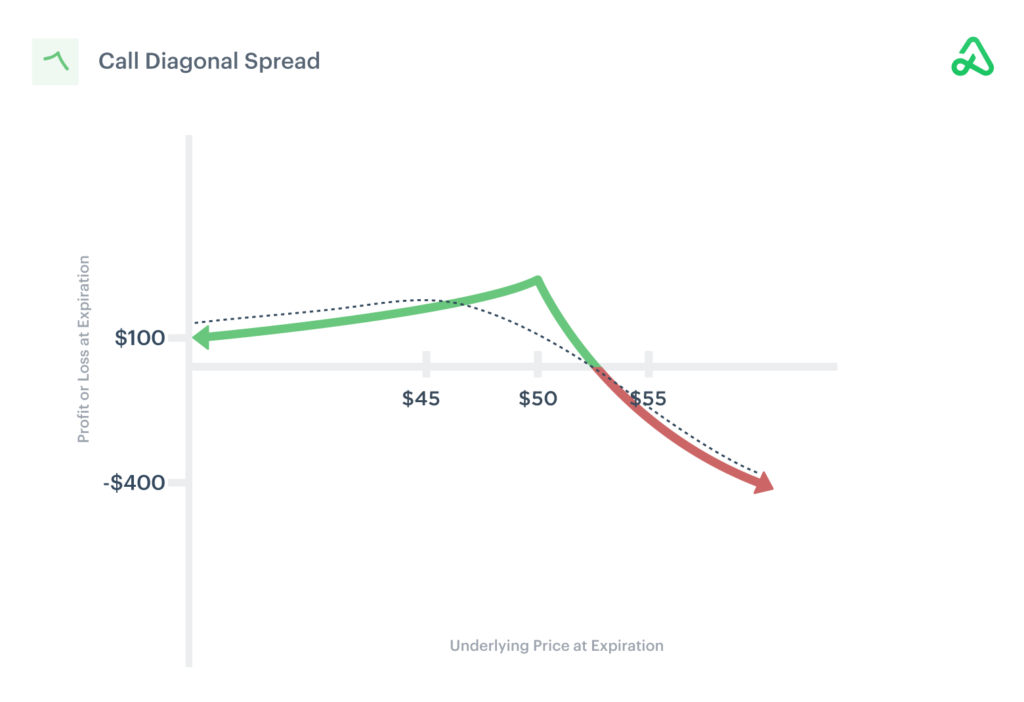
As part of an options trading strategy known as a diagonal spread, one long-term call or put that is ITM/ATM/OTM is purchased, and a shorter-term call or put that is further OTM is sold to lower the cost basis of the long option.
The two options must be of the same kind (long call and short call, or long put and short put).
To guarantee that we can benefit from a significant move in our favor ITM, the cost of the entire trade should ideally be no higher than 75–80% of the spread’s breadth.
Losses may be realized on a significant move ITM if the debit paid exceeds the width of the spread because, if all extrinsic value is lost, the minimum value of the deal equals the width of the spread.
The maximum profit on a diagonal spread can be calculated by subtracting the debit paid from the spread’s width if it is in the money, then adding any remaining extrinsic value in the long option to the calculation.
It is difficult to set a definite estimate on the maximum profit because it depends on the stock price at the time the short strike expires and the short option expires first because of their various expirations.
If the long option expires out-of-the-money (OTM), the maximum loss is just the debit paid for the deal.
Learn more about diagonal spreads
See also- Is Airbnb Profitable In 2023? Where to Invest
Which option Strategy has the Highest Level of Consistency in Profitability?
A Bull Call Spread is created by buying a call option and selling another call option at the same time that has the same expiration date but a lower cost and a higher strike price.
The optimal option selling strategy is also thought to be this.
The most suitable option strategy for you will be dependent on your unique trading goals and risk tolerance. The covered call or cash-secured put may be a great choice for you if you’re searching for a fairly low-risk approach with the possibility for steady profits. The iron condor can be a fantastic option for you if you’re seeking a more detailed plan with a higher likelihood of success.
It is crucial to remember that risk is there in every option trading strategy. Before trading options, you should always carefully assess your risk tolerance and financial objectives. Applying one of the most profitable option strategy for every investor.
5 Secrets to Most Profitable Option Strategy
One of the financial markets’ most adaptable tools is the option.
The trader can use their position to increase returns thanks to their flexibility.
By using these products for hedging or to profit from the market’s upward, downward, and sideways movement, the user is also able to manage risk.
Options trading is highly speculative and bears a significant risk of loss despite its many advantages.
Everyone cannot succeed as an options trader.
Being a successful options trader involves a particular skill set, personality type, and attitude, just like being successful in any other line of work.
1. The Capacity to Manage Risk
Options are high-risk financial instruments, thus traders must understand their current level of risk.
How much may the trade lose in total?
What is the view on volatility, either implicitly or explicitly?
What portion of my capital is dedicated to trade?
These are some of the issues that traders should never forget.
Additionally, traders must control risk by taking the proper precautions.
You will encounter loss-making deals frequently, especially if you trade short-term options.
A poor piece of news could ruin your bet, for instance, if you hold a position overnight.
The risk associated with your holdings needs to be reduced at all times.
To avoid putting all their eggs in one basket, some traders diversify their portfolios and restrict the size of their trades.
2. Be Math Savvy
You are constantly dealing with numbers when trading options. How volatile is implied?
The choice has a positive or negative financial outcome.
How long till the business breaks even? These queries are continuously addressed by options traders.
Additionally, they discuss the Greeks of their option transactions, including the delta, gamma, vega, and theta.
For instance, a trader could be interested in knowing whether his trade is short gamma.
3. Establish Discipline
Options traders need to maintain discipline to succeed.
The discipline includes conducting in-depth research, spotting opportunities, putting up the ideal trade, creating and adhering to a strategy, setting goals, and developing an exit strategy.
Following the herd is a straightforward illustration of straying from the rules.
If you haven’t done your research, never believe an opinion.
You cannot neglect your homework and be blamed for your failures on the herd.
For it to be a good options strategy, you must instead develop a stand-alone trading method that is effective.
4. Remain Calm
Every option trader possesses the virtue of patience.
Instead of attempting to profit significantly from every market movement, patient investors are prepared to wait for the market to present the proper opportunity.
To determine the best timing to make or quit a deal, traders frequently sit motionless and monitor the market.
With novice traders, this is not the case.
They will be fast to enter and exit deals because they lack self-control, are impatient, and cannot wait.
5. Make a Trading Strategy.
Since every trader is unique, they should choose a trading approach that complements their characteristics.
Day trading, in which investors buy and sell options repeatedly throughout the day to generate modest returns, maybe a skill for some traders.
Some individuals may feel more at ease with position trading, where they develop trading plans to capitalize on special possibilities like time decay and volatility.
Likewise, other people might feel more at ease with swing trading, in which investors stake wagers on price movement over intervals of five to thirty days.
Frequently Asked Questions
Q: What is an option strategy?
An option strategy is a set of two or more option trades that are intended to accomplish a particular financial goal. Option methods can be used to make money, prevent losses, or make predictions about the price of stocks in the future.
Q: Which option strategy is right for me?
The ideal option strategy for you will be influenced by your unique trading objectives and risk tolerance. The covered call or cash-secured put may be a great option for you if you’re searching for a reasonably low-risk approach with the possibility for steady profits. The iron condor can be a fantastic option for you if you’re seeking a more complicated plan with a greater chance of success.
Q: How do I choose the right strike price and expiration date for my option trades?
Your own trading goals and level of risk tolerance will determine the right strike price and expiration date for your option trades. If you believe that the stock will rise in value, you should select a strike price that is higher than the present price. Choose a strike price that is lower than the current stock price if you are bearish on the stock. How much time you have for your trade to be profitable depends on the expiration date. You should pick an expiration date that is closer to the current if you’re hoping to make a quick trade. You can select a later expiration date if you’re trying to make a long-term deal.
Q: How do I manage my risk when trading options?
When trading options, there are multiple ways to control your risk. The use of stop-loss orders is one approach. An order to sell your option if it hits a specific price is known as a stop-loss order. If the market turns against you, this might help you in limiting your losses. By using position sizing, you can manage your risk in another method. The act of deciding how much money you will risk on a single trade is known as position size. Risking no more than 2% of your account balance on any one handle is a fair general rule of thumb.
Conclusion
In conclusion, New market participants may find trading options to be scary, but several tactics can help them reduce risk and boost returns.
If you currently own the underlying asset, you may want to consider covered calls, collars, and married puts. Moreover, if the market is moving, you may want to consider straddles and strangles.
We hope this article on the most profitable option strategy has been very beneficial for your perusal.
Kindly let us know which of the above-listed most profitable options strategy you will choose to utilize.
Good luck!
References
- Investopedia.com – 10 Options Strategies to Know
- Tastylive.com – 10 Options Strategies Every Trader Should Know






You’re so awesome! I don’t believe I have read a single thing like that before. So great to find someone with some original thoughts on this topic. Really.. thank you for starting this up. This website is something that is needed on the internet, someone with a little originality!
Thank you for the lovely compliment. Enjoy more reading time with our contents.